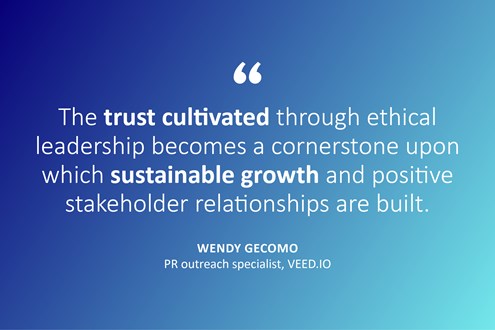The reciprocal relationship between ethical leadership and regulatory compliance

- 12 January 2024
Transparency is becoming a cornerstone of running a successful business. Creating honest and authentic communications and values is something that customers want from the businesses they interact with. PR Outreach Specialist at VEED.IO, Wendy Gecomo, talks to us about how ethical leadership and regulations fit hand in hand.
In the contemporary landscape of business and governance, the relationship between ethical leadership and regulatory compliance stands as a symbiotic alliance, shaping the trajectory of organisations and industries alike. Ethical leadership, characterised by a commitment to transparency, integrity, and the well-being of stakeholders, intertwines with regulatory compliance, providing a structured framework for legal adherence.
This article explores the interconnectedness of ethical leadership and regulatory compliance, emphasising how their harmonious collaboration is integral to fostering a culture of responsibility and sustainability in diverse sectors.
Ethical leadership: A guiding light in corporate governance
Ethical leadership functions as the guiding force for organisations moving towards principled decision-making and responsible behaviour. Leaders entrenched in ethical principles exemplify a commitment to core values such as honesty, fairness, and social responsibility, injecting these values into the organisational ethos. The prioritisation of honesty ensures transparent communication, fostering an atmosphere where information flows openly and truthfully. Fairness becomes a guiding principle, promoting equitable treatment for employees, customers, and stakeholders, thereby cultivating a workplace where opportunities are distributed fairly, and decisions are made impartially. Social responsibility extends the organisational horizon beyond profit motives, compelling leaders to consider the broader impact of their actions on the community and society at large.
CIM course director Duncan Smith explains: “We temper our messaging in line with codes of practice; codes which themselves are based on long-established legislation and case law.”
Within the organisational framework, ethical leaders play a transformative role by nurturing a culture of integrity. This cultural emphasis on ethical considerations becomes a bedrock, instilling confidence and trust among employees who recognise the organisation's commitment to principled conduct. This trust ripples outward, influencing customer perceptions and encouraging loyalty. Beyond the confines of the organisation, the broader community becomes a stakeholder in this culture of integrity, appreciating and endorsing the positive impact of an ethically-driven organisation. In this way, the trust cultivated through ethical leadership becomes not just a desirable outcome but a foundational element, a cornerstone upon which sustainable growth and positive stakeholder relationships are built.
Regulatory compliance: Navigating the legal landscape
Regulatory compliance constitutes the steadfast commitment of organisations to adhere to a myriad of laws, standards, and industry regulations meticulously designed to govern specific sectors. These regulations are a structured framework intended not only to uphold the principles of fair business practices but also to safeguard the interests of consumers and preserve the overall integrity of industries. Embracing regulatory compliance is essential for organisations as it signifies a dedication to operating within the boundaries of established legal frameworks, ensuring that their activities are transparent, ethical, and aligned with the broader societal expectations.
While compliance is frequently perceived through a legal lens, its significance transcends the mere avoidance of penalties or legal ramifications. Compliance, in essence, establishes a fundamental baseline for ethical conduct and responsible governance within organisations. It acts as a compass guiding companies toward practices that not only adhere to the letter of the law but also uphold ethical standards, fostering a culture of accountability and integrity. By meeting regulatory requirements, organisations signal their commitment to responsible business practices, reinforcing trust among stakeholders and contributing to the overall stability and credibility of the industries in which they operate.
Duncan Smith thinks that we should also consider the implications of AI to ethical leadership and regulatory compliance: “The professional marketer would do well to avail themselves of a solid understanding not only the increased regulatory risks of this progression to more AI enabled workflows, but also the ethical implications of unbridled adoption.”

The symbiotic relationship
The relationship between ethical leadership and regulatory compliance is symbiotic. Ethical leaders set the tone for responsible practices, instilling a culture of integrity that naturally aligns with regulatory requirements. Conversely, regulatory compliance acts as a guidepost for ethical conduct, providing a structured framework within which ethical decisions can flourish.
Video editing software companies and other companies which use the material generated by the consumer which place importance on ethical leadership are often better positioned to navigate the complexities of regulatory compliance seamlessly. By fostering a culture of transparency, accountability, and user-centric design, these companies not only meet legal requirements but also build trust with their user base.
The audio-visual symbiosis
The integration of audio into video content represents an innovative evolution in communication strategies. From marketing campaigns to internal training materials, the combination of sight and sound enhances the impact and engagement of the message. However, with this innovation comes the responsibility to uphold ethical considerations and comply with relevant regulations. Ethical leaders understand the power of multimedia communication and strive to ensure that audio-visual content respects privacy, avoids manipulation, and adheres to truthfulness and transparency.
Approaching ethical audio-visual integration
Truthful representation: Ethical audio-visual content accurately represents information, avoiding misleading visuals or manipulation when adding audio to video. Truthful storytelling builds trust and credibility with the audience.
Respect for privacy: Integrating audio into video should respect privacy rights. Whether it's customer testimonials or internal communications, ethical leaders ensure that personal information is handled with care and in compliance with data protection laws.
Inclusivity and diversity: Ethical leaders embrace the opportunity to promote inclusivity and diversity in audio-visual content. Audio editors ensuring representation and avoiding stereotypes contribute to a more responsible and socially conscious approach.
Compliance with intellectual property laws: Ethical audio-visual integration necessitates compliance with intellectual property laws. Properly attributing and seeking permission for audio elements ensures ethical practices and legal adherence.
The symbiosis unveiled
The synergy between ethical leadership and regulatory compliance manifests as organisations seamlessly intertwine ethical values with their compliance strategies. Ethical leaders transcend mere legal obligations, elevating their commitment to principled conduct beyond the minimum requirements. This commitment fosters a pervasive culture of ethical decision-making that resonates at every level of the organisation. Regulatory compliance, in this context, serves as a guiding framework that not only ensures legal conformity but also actively reinforces ethical standards. The dynamic interplay between ethical leadership and regulatory compliance establishes a harmonious cycle wherein adherence to legal mandates reinforces the cultivation of a culture deeply rooted in responsible and ethical conduct, ultimately contributing to the organisation's sustained success and positive impact on stakeholders.
Benefits of the symbiotic relationship
Cultivation of trust: Ethical leadership and regulatory compliance collectively contribute to the cultivation of trust. When organisations demonstrate a commitment to both ethical values and legal obligations, stakeholders develop confidence in the integrity and reliability of the organisation.
Risk mitigation: The symbiotic relationship helps mitigate risks associated with legal violations and unethical behaviour. By embedding ethical considerations into compliance efforts, organisations proactively address potential pitfalls and navigate regulatory landscapes with a heightened awareness of ethical implications.
Enhanced reputation: Organisations that prioritise ethical leadership alongside regulatory compliance often enjoy an enhanced reputation. This positive perception not only attracts customers but also establishes the organisation as a responsible and trustworthy player in the industry.
Innovation and adaptability: Ethical leaders, in collaboration with regulatory compliance efforts, foster a culture of innovation and adaptability. By considering ethical implications in compliance strategies, organisations are better equipped to navigate evolving regulatory landscapes and proactively address emerging ethical challenges.
Challenges and opportunities: While the symbiotic relationship between ethical leadership and regulatory compliance presents numerous advantages, challenges also exist. Striking the right balance requires ongoing commitment, education, and a proactive approach to addressing ethical dilemmas within the confines of regulatory frameworks.
Conclusion
In the intricate dance between ethical leadership and regulatory compliance, organisations find a pathway to sustainable success. This symbiotic alliance goes beyond mere legal adherence; it encapsulates a commitment to ethical values that, when integrated into the organisational DNA, fosters a culture of responsibility, trust, and resilience. As industries evolve and face new challenges, the symbiosis between ethical leadership and regulatory compliance remains a guiding light, steering organisations toward a future where ethical conduct and legal integrity form the bedrock of corporate governance.
If you want to have a deeper understanding of the potential ethical and legal challenges associated with generative AI, sign up to our Generative AI and The Law training course.

- 0 views

 FAQs
FAQs
 Log in
Log in
 MyCIM
MyCIM





